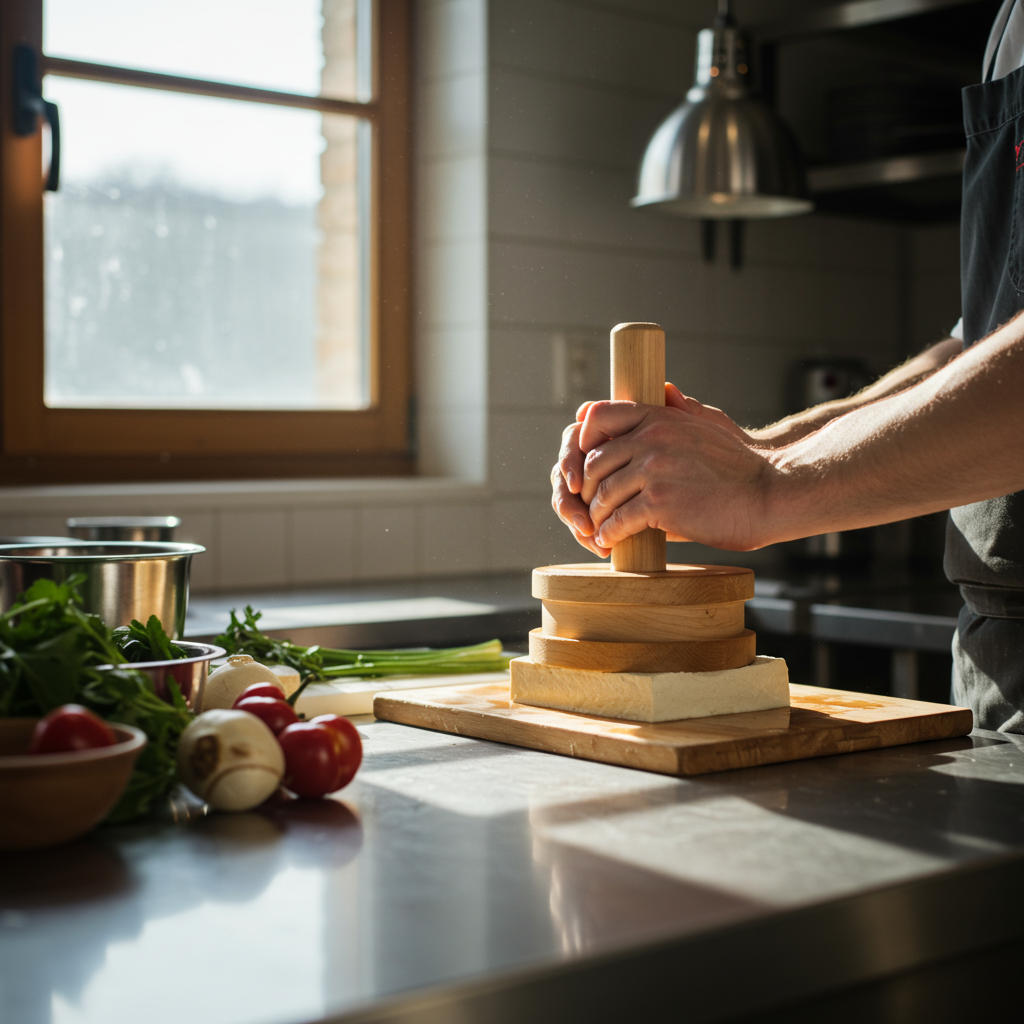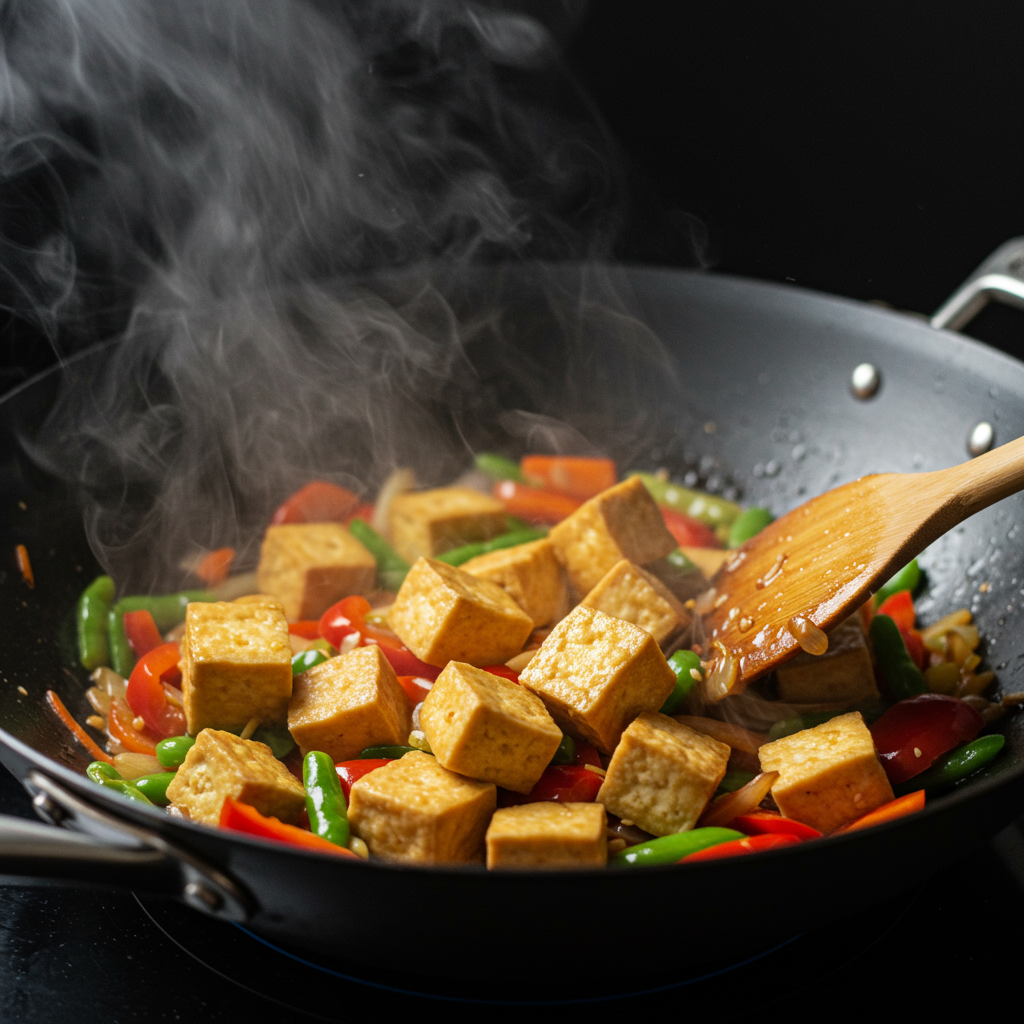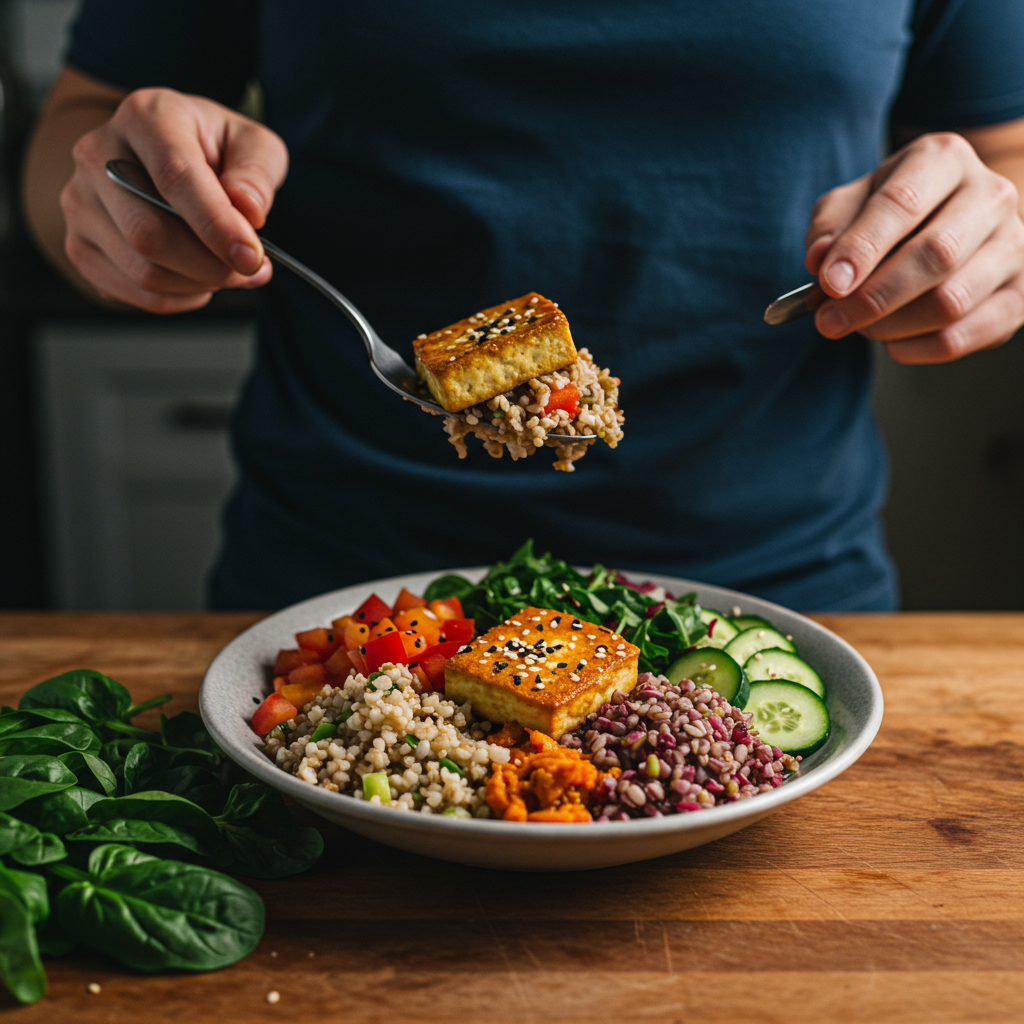
Table of Contents
Introduction
Tofu, a humble yet incredibly versatile plant-based protein, has been gaining popularity in kitchens around the world. Whether you’re a seasoned cook or just starting your culinary journey, you might find yourself wondering how to master cooking with tofu to create delicious, nutritious dishes. Imagine turning a block of bland soy product into a flavorful feast that delights not only vegans and vegetarians but anyone looking for healthy, satisfying meals. This guide is designed to help beginners like you unlock the full potential of tofu in your cooking repertoire.
Why does learning to cook with tofu matter? In today’s diverse food landscape, plant-based eating is embracing an exciting resurgence, driven both by health consciousness and environmental sustainability. Tofu shines as a low-calorie, high-protein option that fits perfectly into these lifestyles. Its ability to absorb flavors and adapt to countless cooking techniques makes tofu an excellent staple for a variety of cuisines. While you might have seen tofu on menus or in recipe books, understanding its nuances and knowing how to prepare it properly is the key to transforming it from a mystery ingredient into a culinary star.
Many people are daunted by the thought of cooking tofu because of its delicate texture and mildly bland taste straight out of the package. However, with the right knowledge and skills, tofu can be incredibly rewarding to cook with. From achieving the perfect crispy crust in a stir-fry to blending it smoothly into creamy sauces or desserts, the possibilities are endless. This guide addresses common beginner concerns, such as how to select the right type of tofu, techniques to improve texture, and flavoring tips to make each dish your own. You’re not alone in this learning process — countless home cooks have faced similar challenges and found joy in mastering tofu.
Cooking with tofu also offers great benefits beyond taste and nutrition. It’s an affordable protein source suitable for budget-conscious home chefs. It’s also rich in essential nutrients such as iron, calcium (especially if fortified), and contains all nine essential amino acids, making it a complete protein. For those managing dietary restrictions or seeking healthier alternatives to meat, tofu provides a flexible and wholesome option. By learning how to prepare tofu well, you’re equipping yourself with a powerful ingredient that supports a balanced and varied diet.
What You’ll Learn in This Guide
This comprehensive beginner’s guide is crafted to walk you through the essentials and beyond of cooking with tofu. Whether you’re looking to understand the basics or eager to try flavorful recipes, this resource provides step-by-step insights to boost your confidence and culinary skills.
- Understanding Different Types of Tofu: We’ll introduce the most common tofu varieties such as silken, soft, firm, and extra firm tofu. You’ll learn how each type’s texture and moisture content affect cooking methods and final dish outcomes, so you can select the best tofu type for your recipes confidently.
- Preparing Tofu for Cooking: Discover effective techniques like pressing to remove excess moisture, marinating to infuse flavor, and slicing methods that optimize texture and taste. These preparation steps are fundamental to making tofu delicious and enjoyable.
- Popular Cooking Methods: Explore various ways to cook tofu, including stir-frying, baking, grilling, and pan-frying. Each method brings out different textures and flavors, and we’ll provide detailed tips to master these techniques for tasty results every time.
- Delicious Tofu Recipes and Tips: From simple stir-fries to hearty baked tofu bowls, this guide offers recipe ideas that are beginner-friendly and bursting with flavor. Additionally, you’ll learn valuable tips and tricks to avoid common mistakes, ensure perfect texture, and store tofu correctly for convenience.
With these topics covered, you’ll not only learn how to cook tofu but also gain a deeper appreciation for its versatility and health benefits. Each section builds on the previous, guiding you from understanding the ingredient to creating satisfying meals that showcase tofu’s best qualities.
In the subsequent sections, we will delve deeper into the different types of tofu so you can identify which one suits your cooking style and recipe needs. We’ll then talk about the critical preparation techniques such as pressing and marinating that make all the difference in flavor and texture. Next, you’ll find detailed explanations on popular cooking methods, including tips to get the perfect crispiness or softness you desire. Finally, we’ll inspire you with a selection of delicious recipes that demonstrate just how exciting cooking with tofu can be.
Whether you’re looking to reduce meat consumption, add more plant-based meals to your diet, or simply experiment with new ingredients, this beginner’s guide is your friendly companion on the journey. By the end, tofu will no longer feel intimidating but instead a versatile, tasty ingredient that complements your lifestyle and culinary creativity.
So let’s get started on transforming your approach to tofu, uncovering its many uses, and empowering you to create mouthwatering dishes that nourish both body and soul. Your new culinary adventure with tofu begins here — exciting, flavorful, and full of possibilities!

To truly master cooking with tofu, it’s essential to move beyond the basics covered in the introduction and delve into the nuances of selecting the right tofu type and preparing it properly. Cooking tofu can be a rewarding experience when you understand how its different varieties behave and how proper preparation techniques make a significant difference in flavor and texture. This discussion will explore the essentials of tofu types and their cooking applications, followed by preparation methods that set the stage for delicious results. Armed with this knowledge, beginners can confidently experiment with recipes and enjoy the versatility of tofu as a nutritious plant-based protein.
Understanding Different Types of Tofu and Their Cooking Uses
Tofu comes in multiple varieties, each designed for specific culinary applications based on texture and moisture content. Understanding these types is key to choosing the best tofu for your intended recipe and cooking style. Silken tofu, with its smooth, soft texture, works well in dishes requiring a creamy consistency such as smoothies or desserts. Soft tofu is slightly firmer yet still delicate, making it ideal for gentle cooking methods like simmering in soups or stews where it can absorb surrounding flavors without breaking apart easily. Firm and extra-firm tofu pack more density and hold their shape under higher heat, making them perfect for frying, grilling, or baking. Getting familiar with these tofu types opens up a world of preparation options and helps avoid common pitfalls like tofu crumbling or not absorbing marinades well.
Knowing the right tofu type and matching it to cooking technique also influences the dish’s final texture and flavor uptake. For example, using firm tofu for stir-fry allows you to achieve crisp edges while keeping a tender interior, whereas silken tofu’s creamy texture complements blended sauces. Careful selection can elevate your dish by providing the right mouthfeel and balance. To fully grasp this concept, it helps to understand the differences in tofu production and moisture levels, which directly impact cooking outcomes. Learning about these variations encourages better culinary experimentation and confidence in the kitchen.
Key Aspects of Tofu Varieties
Each tofu type offers unique advantages suited to specific culinary goals. Consider the following key points when deciding which tofu to use:
- Silken Tofu: Known for its velvety texture, it blends smoothly into soups, desserts, and smoothies. It’s delicate, so handle carefully and avoid high-heat cooking methods that can break it apart.
- Soft Tofu: Has a slightly firmer form than silken, ideal for dishes needing tender tofu that holds shape a little better, such as miso soup or gentle braises.
- Firm and Extra Firm Tofu: These types retain structure under intense cooking like frying, baking, and grilling. They provide a satisfying chew and absorb marinades well with proper preparation for enhanced flavor.
- Understanding Texture Impact: Moisture content varies widely; silken contains the most water making it unsuitable for crisp textures while extra-firm holds minimal moisture enabling it to brown nicely and develop crunch.
Preparing Tofu for Optimal Cooking Results
Preparation is just as important as choosing the right tofu type. Proper handling techniques transform tofu from bland blocks into flavorful, texturally pleasing ingredients. One foundational step is pressing tofu to remove excess water, which can otherwise prevent it from crisping or absorbing marinades effectively. Pressing improves texture, enhances cooking performance, and boosts flavor profile by allowing seasonings to penetrate deeply. Beginners may find pressing intimidating, but simple methods using household items make it accessible.
Marinating tofu after pressing is another crucial practice to infuse it with bold flavors that stand out in any dish. Popular marinades blend soy sauce, garlic, ginger, and acid components like vinegar or citrus. The marinating duration generally ranges from 30 minutes to several hours depending on desired intensity. Effective marination coupled with proper cooking techniques like baking or pan-frying transforms tofu into a savory, satisfying main or accompaniment. For a detailed breakdown of these steps, see our guide on choosing the right products and care for sensitive skin to understand parallels in gentle and careful treatment that enhances overall results.
Essential Preparation Techniques for Tofu
Preparing tofu well requires attention to a few important factors to maximize culinary success:
- Pressing Tofu: Remove excess liquid to improve texture, especially for firm varieties. Pressing can be done with tofu presses or household items like a plate weighted with cans. This step helps tofu crisp up and absorb marinades more effectively.
- Marinating Tofu: Saturate tofu with flavorful mixtures that balance umami, acid, and spice elements. Marinate for at least 30 minutes and up to overnight for deeper flavor penetration.
- Cutting and Handling: Cut tofu into consistent shapes such as cubes or slices to ensure even cooking. Handle gently to prevent breaking, especially for softer types.
- Drying Surface: Pat tofu dry after pressing and before cooking to promote browning and prevent sticking. Proper drying is crucial for techniques like pan-frying or baking.

Conclusion
Cooking with tofu offers an exciting journey into versatile, healthy, and flavorful plant-based meals. Understanding the different types of tofu—silken, soft, firm, and extra firm—is fundamental to unlocking its culinary potential. Each variety brings unique textures and moisture levels that align best with specific cooking methods and dishes. For example, silken tofu’s delicate texture is perfect for smoothies and creamy desserts, while firm and extra-firm tofu withstand stir-frying, baking, and grilling beautifully. Appreciating these distinctions successfully guides you in choosing the right tofu for your recipe goals and desired texture.
Preparation techniques play a crucial role in maximizing tofu’s flavor and texture benefits. Pressing tofu to remove excess water creates a firmer bite and allows marinades to penetrate deeply, while careful marinating introduces vibrant layers of taste. Cutting tofu into appropriate shapes depending on the cooking method ensures even cooking and appealing presentation. Cooking methods from stir-frying to baking provide diverse options to create delicious meals ranging from crispy and savory to soft and comforting. Equipped with these insights, cooking with tofu transforms from an intimidating task into a rewarding creative experience.
The essence of mastering tofu lies in attention to detail and experimentation. With knowledge of tofu varieties and preparation tips, you can tweak marinades, cooking times, and seasoning to suit your palate. Whether you are crafting a quick stir-fry, a hearty baked tofu bowl, or a smooth dessert blend, tofu remains a canvas waiting for your personal touch. Understanding the science of tofu texture and flavor absorption empowers you to cook with confidence and imagination, making every meal more delightful.
To start putting this knowledge into practice, begin with pressing firm or extra-firm tofu before cooking to achieve that desirable crispiness and flavor infusion. Experiment with simple marinades like soy sauce, garlic, and citrus to find combinations you enjoy. Try different cooking methods and notice how the texture and taste evolve, from the crunch of pan-frying to the tender softness of baking. Taking small, manageable steps encourages a deeper appreciation and skill development in cooking tofu, making your plant-based meals varied and enjoyable.
Remember that cooking is both science and art—allow yourself room to try, fail, adjust, and succeed. Continuously explore new recipes and flavor profiles to keep your tofu dishes exciting and satisfying. Embrace tofu as a versatile ingredient that supports a nutritious, balanced diet while inviting creativity. With patience and practice, you will discover the joy of transforming a simple block of tofu into memorable meals that nourish both body and soul.
